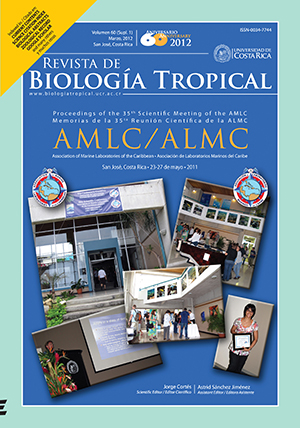Abstract
Ocean acidification is altering the calcification of corals, but the mechanism is still unclear. To explore what controls calcification, small pieces from the edges of thin plates of Agaricia agaricites were suspended from a torsion microbalance into gently stirred, temperature controlled, seawater. Net calcification rates were monitored while light, temperature and pH were manipulated singly. The living coral pieces were sensitive to changes in conditions, especially light, and calcification was often suspended for one or two hours or overnight. The mean calcification rate increased from 0.06 in the dark to 0.10 mg.h-1.cm-2 (T test, n=8, p<0.01) in low light (15 μmol.s-1.m-2) and showed a positive linear relationship with temperature. With a reduction of mean pH from 8.2 to 7.6 the mean calcification rate in the light (65 μmol.s-1.m-2) increased from 0.19 to 0.28 mg.h-1.cm-2 (T test, n=8, p<0.05) indicating a dependency on carbon dioxide. After waterpiking and exposure of the skeletal surface/organic matrix to seawater, calcification showed an astonishing initial increase of more than an order of magnitude then decreased following a non-linear generalised Michaelis-Menten growth curve and reached a steady rate. Calcification rate of the freshly waterpiked coral was not influenced by light and was positively correlated with temperature. For a mean pH reduction from 8.1 to 7.6 the mean calcification rate increased from 0.18 to 0.32 mg.h-1.cm-2 (T test, n=11, p<0.02) again indicating a dependency on carbon dioxide. Calcification ceased in the presence of the carbonic anhydrase inhibitor azolamide. Staining confirmed the presence of carbonic anhydrase, particularly on the ridges of septae. After immersion of waterpiked corals in seawater for 48 hours weight gain and loss became linear and positively correlated to temperature. When the mean pH was reduced from 8.2 to 7.5 the mean rate of weight gain decreased from 0.25 to 0.13 mg.h-1.cm-2 (T test, n=6, p<0.05) indicating a dependence on carbonate. At a pH of 6.5 the skeleton lost weight at a rate of 1.8 mg.h-1.cm-2. The relationship between net calcification and pH (n=2) indicates that wt gain turns to loss at pH 7.4. These experiments confirm that calcification is a two-step process, involving secretion of a layer of organic matrix incorporating carbonic anhydrase to produce an active calcifying surface which uses carbon dioxide rather than carbonate. It is also unlikely that the calcifying surface is in direct contact with seawater. Inorganic deposition or dissolution of the skeleton in exposed dead areas of coral is a different phenomenon and is carbonate related. The wide range in results from this and other studies of calcification rate and carbon dioxide may be explainable in terms of the ratio of “live” to “dead” areas of coralComments
Downloads
Download data is not yet available.






